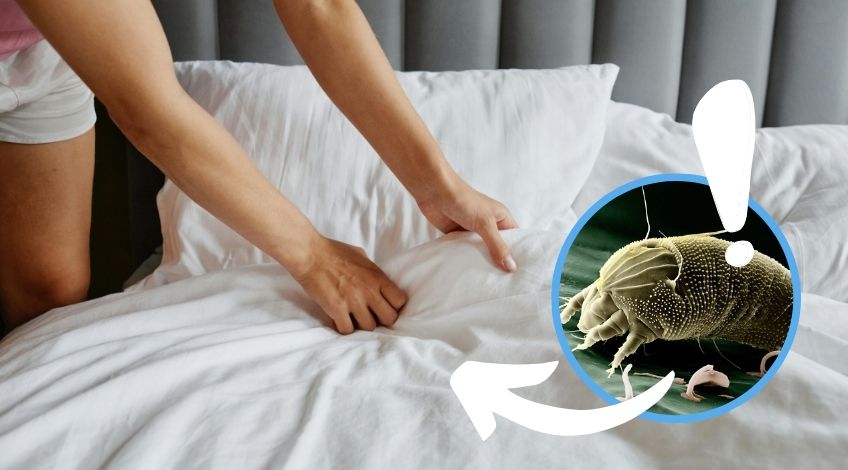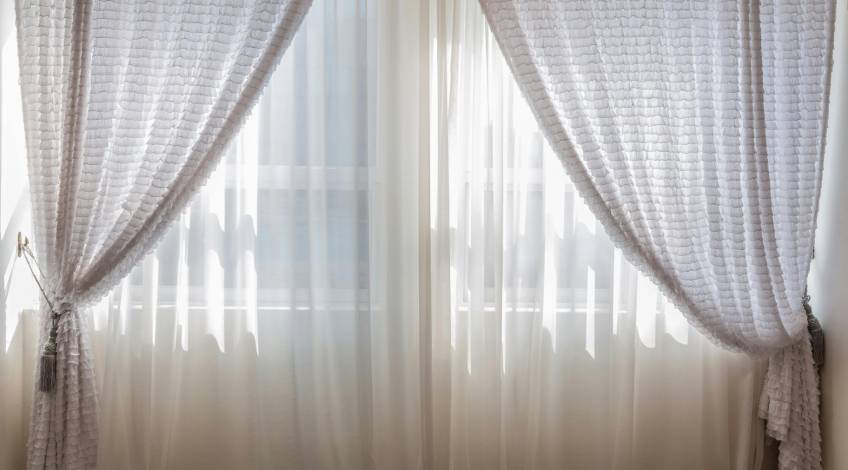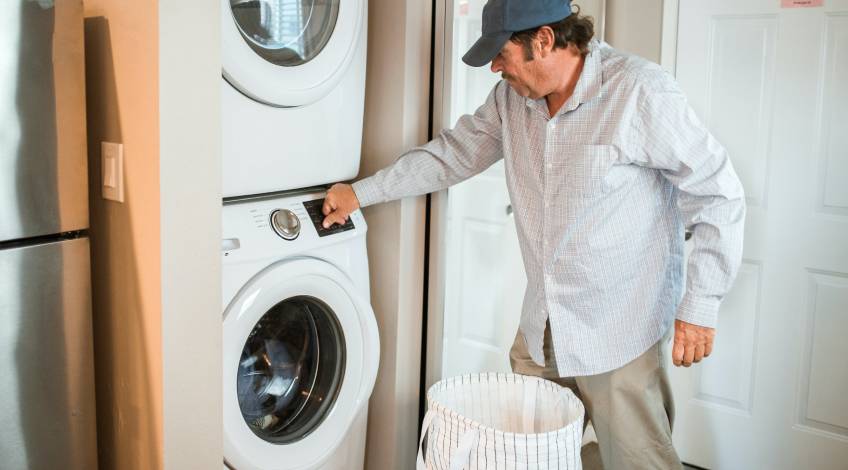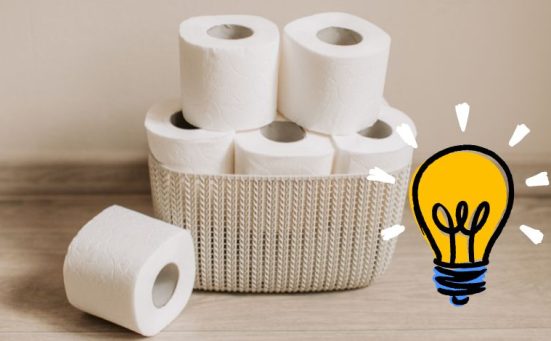
You’re Washing Your Comforter Wrong And Dust Mites Love That
When the long working day is over, nothing feels better than getting into a bed with crisp, clean, fresh bed sheets and getting a good night’s sleep. Unfortunately, if you’re one of the estimated 12 million people in the UK that suffers from allergies caused by dust mites, it might not be that simple.
If you do suffer from dust mite allergies just getting into bed can be the start of a coughing or sneezing fit or your skin problems could become worse and prevent you from sleeping. In this article we’ll show you how to alleviate this problem and offer advice on the best way to remove dust mites from your bed. Fancy a decent night’s sleep? Keep reading to find out how to make sure the dust mite population in your bed is seriously reduced.
What Are Dust Mites?
Dust mites (AKA bed mites) are extremely small and usually measure between 0.2 to 0.3 mm in length. They’re invisible to the naked eye and can only be seen under a microscope.
They live in our homes and feed off dead skin which we discard every night as we sleep. They prefer damp, dusty areas which is why they are almost always found in our beds. However, they can typically also be found in upholstery, carpet and soft fluffy toys.
They also flourish in humid environments, so homes with poor ventilation or high indoor humidity can see significantly higher populations. Their tiny bodies and waste particles are light enough to become airborne with even slight movements, such as sitting down on a bed or walking across a carpet.
It turns out that there are various species of dust mite and they can all trigger the same allergic reactions. Whichever species of dust mite is present in your home, they can all be dealt with in the same way. However, dust mites should not be confused with bed bugs.
What Are The Differences Between Dust Mites & Bed Bugs?

The main differences between dust mites and bed bugs is that bed bugs are much larger. They measure around 5 mm in length which makes them visible to the naked eye. Plus bed bugs feed on human blood and bite sleepers during the night.
They don’t discriminate and will bite anyone and everyone whereas allergies to dust mites only affect certain people. Dust mites don’t bite either, they feed on discarded dead skin that falls from our bodies as we sleep.
What Symptoms Are Present With Dust Mite Allergy?
The reality is that dust mites are present in every home, even the cleanest and tidiest homes will have a population of dust mites. In an average home, dust mite numbers are estimated to be in their thousands or even millions.
As they’re so small, most people are unaware of their presence at all. They only become problematic when someone suffers from a dust mite allergy.
People with a dust mite allergy are allergic to their droppings and when these droppings are disturbed, by getting into bed or walking on carpeted floors, the droppings are raised into the air and people then breathe them in or get them settled on their bodies.
For the most part these droppings cause no problems at all but if you’re allergic to them, it’s a whole different matter. Symptoms of a dust mite allergy include;
- A runny nose or sneezing
- Nasal drip
- Coughing
- An asthma attack
- Itchy mouth
- Throat irritation
- Itchy skin
- Skin rash
- Dermatitis
These symptoms can be especially intense during the night or first thing in the morning, as extended exposure during sleep allows allergens to accumulate on the skin and in the respiratory system. If caused by a dust mite allergy your symptoms will be worsened when you get into bed or are in a room with carpet, curtains and/or upholstery.
Who Is Most Likely To Suffer From Dust Mite Allergies?

Despite numerous studies, it’s not known why some people are triggered by dust mite allergies, but some people are more likely to be affected than others. You’re most likely to suffer from a dust mite allergy if you already suffer from any of the following;
- Hay Fever (or other allergies)
- Eczema
- Psoriasis (or other skin conditions)
- Asthma (or other respiratory issues)
However, these same symptoms could have any number of causes and might not have anything to do with dust mites. The best way to tell if you’re allergic to dust mites is to get an allergy test.
How To Combat Dust Mites

The thing is no matter how much cleaning you do, you’re never going to completely eradicate dust mites from your home. However, by drastically reducing their number you can alleviate the symptoms caused by your allergy.
Wash Bedding Weekly
The first thing you need to be doing is following a strict washing routine of all of your bedding. Sheets and pillowcases should be washed every week in as hot a wash as the fabric allows.
Ideally you should wash sheets and pillow cases at 60oC to be sure of killing dust mites. If your fabrics can’t withstand that heat, it’s time to change your sheets and pillowcases for some that can.
Vacuum Your Mattress
It’s also a good idea to get a mattress protector which will help to prevent dust mites from getting established in your mattress. Another good idea is to clean the mattress every week.
Obviously you can’t put the mattress in your washing machine, but you can vacuum it once a week using a handheld vacuum.
Dust Regularly
Unfortunately dust mites can live on any surface so you need to dust regularly and vacuum floors and surfaces frequently. When dusting, you should use a damp cloth because the dampness traps dust and prevents it from spreading around the room.
If you or a household member suffers from severe allergies or asthma, consider investing in a HEPA filter vacuum cleaner. These are specifically designed to trap microscopic allergens, including dust mite waste, and prevent them from being recirculated into the air.
Don’t Forget About Curtains & Upholstery

You should also pay particular attention to curtains and upholstery as well as carpets. Your vacuum will have an attachment designed specifically for all of these places and you should vacuum them weekly.
Make Sure Your Vacuum Is Clean
It’s essential to use your vacuum to help eradicate those dust mites. But a dirty vacuum isn’t going to be able to handle dirt and dust efficiently. Be sure to empty the dust bag and clean the filter on your vacuum regularly to ensure it works at its optimum best.
Use Anti-Allergy Bedding
If, after performing all of the above, your allergies are just as bad, consider replacing your bedding with anti-allergy bedding. You can buy hypoallergenic pillows and duvets which are made from synthetic materials that help to repel dust mites and other allergens.
Keep Humidity Down
Dust mites thrive in warm, damp conditions and feed on certain types of mould. Which means that if your bedroom is poorly ventilated and humid, dust mite numbers will increase.
You can invest in a dehumidifier to get the humidity down to below around 50%. You can also air the room by opening the window at least once or twice a week.
How Frequently Should You Wash Your Comforter?
How often your comforter needs to be washed depends on what it’s filled with. If your comforter is filled with cotton, polyester or a down alternative, it should be washed at least once a month.
If you have pets that sleep on your bed with you, and you suffer from allergies, you should increase the washing frequency to at least once every fortnight. However, if your comforter has a separate cover, which is common for down filled comforters, the actual comforter only needs to be washed around twice per year. But the cover should be washed every week along with the sheets and pillowcases.
The Best Way To Wash A Comforter

To ensure that your comforter is clean and dust mite free you should follow this guide;
You Will Need;
- Detergent
- Stain Remover (if applicable)
- Large Washing Machine & Dryer
- Wool Drying Balls (or tennis balls)
Method;
- Shake The Comforter
Shake the comforter to remove any loose dirt, crumbs or hairs as well as making sure the filling is evenly distributed. It’s also worth checking for any loose stitching or small holes before washing, as these can worsen during a wash cycle and lead to leaking of the filling. - Use Stain Remover
If you notice any stains on the comforter, these should be spot treated using a stain remover. - Machine Wash
Make sure that your washing machine has a large enough capacity to accommodate your comforter and allow it to move freely around the drum. If not you’ll need to take your comforter to a commercial laundry. Set the wash cycle to bedding, bulky or delicate wash depending on the settings on your machine. Wash on a cold or warm wash and use a detergent that is gentle on your skin. - Dry
Make sure that your dryer is also large enough to allow the comforter to move freely around the drum or use a commercial laundry if not. As you put the comforter in the drum, spread it out as much as you can to help speed up the drying process. Then add 2 or 3 wool dryer balls or clean tennis balls to help fluff the comforter up and help it dry faster. Set the heat to low and start the dryer.
What About Down Comforters?
Down comforters are filled with duck or geese feathers and these types of comforters need to be protected to make them last longer. Your down comforter should be covered with a duvet cover and although the cover should be washed every week, the actual comforter only needs washing an average of twice a year.
Most down comforters can be washed and dried at home in much the same way as non down filled comforters. However, it is vitally important that the comforter is fully dried before putting it back on the bed.
You can check for damp spots by feeling along the seams and corners, these areas often take longer to dry. If needed, run the comforter through multiple low heat drying cycles, breaking them up with fluffing in between.
This is because the feathers are likely to rot if they are damp. If you are in any doubt about getting your down filled comforter washed and dried at home, you might be better off taking it to a professional launderer. In fact, you should check the care label anyway because some down filled duvets should only be professionally laundered.
Care & Maintenance Tips

Let’s finish with a few tips on how to care for your comforter. They include;
- Interrupt The Drying Cycle
It’s a good idea to stop the drying midway through the cycle and give the comforter a shake to prevent any damp patches getting trapped in the creases. - Store Loosely
Comforters should be loosely folded and placed on a shelf or better still inside a cotton bag in a well aired space. This prevents mildew and damp smells. - Re-fluff The Comforter Between Washes
Every few weeks, place the comforter in the dryer and run a no heat cycle to re-fluff the filling. - Take Your Comforter To A Professional laundry
If your washing machine and dryer don’t have sufficient capacity for your comforter, you should take it to a professional launderer but don’t get it dry cleaned. Dry cleaning uses harsh chemicals that could damage the feather filling. - Shower Regularly
Don’t forget to shower and change into fresh clothing before bed, especially during high pollen seasons. This can help to reduce the amount of allergens being brought into bed with you and complement all of the other steps you’ve taken to reduce dust mites in your sleeping space.
Sleep Better By Taking Control Of Your Bedding Hygiene
Living with a dust mite allergy doesn’t mean resigning yourself to restless nights and constant discomfort. By staying on top of your cleaning routine, being mindful of the materials you sleep on, and understanding the conditions that dust mites thrive in, you can significantly reduce their impact on your health.
Remember, a cleaner, healthier bed doesn’t just help you breathe easier, it also improves your sleep quality and overall wellbeing. So next time you sink into bed, you’ll do so knowing it’s as fresh, hygienic, and allergy friendly as it can be.
SEE ALSO: The Weird Laundry Hack That Cuts Drying Time AND Makes Bedding Hotel-Fluffy
Frequently Asked Questions
You should wash bedding at 60°C. This temperature is high enough to kill dust mites and remove allergens effectively.
If it’s filled with synthetic materials like polyester or cotton, you should wash your comforter once a month, or every fortnight if pets sleep on the bed. Down comforters need washing only twice a year, but their covers should be washed weekly.
Yes, vacuuming can help reduce dust mites especially if you use a vacuum with a HEPA filter. Vacuuming your mattress, carpets, and upholstery regularly can significantly reduce the number of dust mites and their droppings.
No, dust mites are not the same as bed bugs. Dust mites are microscopic and feed on dead skin, whereas bed bugs are visible to the eye, feed on blood, and bite humans during the night.
Also, follow us on Pinterest ...



